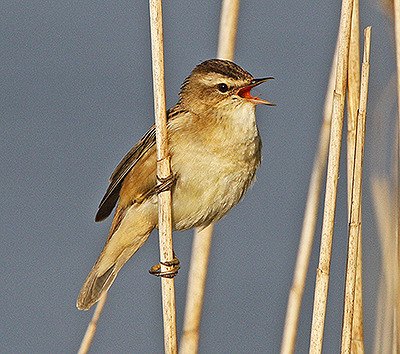Sussex Wildlife Trust: I bless the rains down in Africa
May 30th, 2020
It’s amazing how a song can transport you someplace else. I can’t hear ‘Africa’ by American soft-rockers Toto without drifting back 35 years to a school disco in Plymouth. Right now I’m sat by a Sussex reedbed listening to two songs simultaneously pouring from deep in the reeds. These songs also take me back to my childhood and Saturday mornings spent bird watching beside similar reedbeds in South Devon.
These summer singers are two small brown birds; the Reed Warbler and the Sedge Warbler and their songs make me feel strangely nostalgic for a place I have never been; Ghana, where these warblers will have spent the winter before returning to Sussex each spring.
Reed Warblers are rather plain whereas Sedge Warblers sport a streaky back and stripy head with a heavy ‘eyebrow’ that fixes them with a permanently intense expression. But these identification features aren’t important because you’ll rarely see these secretive birds. But, boy, will you hear them! Because when they start singing they just can’t stop.
The Reed Warbler’s song is a loud, repetitive stuttering chatter of jumbled phrases that just just doesn’t just doesn’t seem to just just just just doesn’t just doesn’t seem to seem to go anywhere. It sounds like one of those warehouse-sized 1950’s computers churning out data.
The Sedge Warbler’s song is similar but much more energetic and erratic with added harsh ‘churrrs’ and whistles giving the overall impression that it urgently needs a straightjacket and heavy medication.
These complex songs have a simple message; ‘Hey ladies, my territory is so rich in insects that I don’t have to spend much time hunting for my food; I can waste my time just singing’. It’s the loudest, longest, craziest song that will seduce a feathered female.
Sedge Warblers raise their family in a no-thrills nest low in vegetation but the Reed Warbler weaves an incredible deep hammock lashed together with spider silk between the stiff stems of the tall reeds. The whole cradle will rock as the reeds bow in the breeze.
In August, after raising their families, their warbler thoughts drift back to Africa where drums echo and wild dogs cry out in the night. The warblers will gorge themselves with aphids and, with a fat belly full of fuel, take off from Sussex and head over Iberia, North Africa and the wide Sahara to Ghana; a 3000 mile journey.
I always imagine a Ghanaian naturalist pausing momentarily each autumn to observe these returning visitors. Do his thoughts drift to the Sussex riverside where they spent the summer?
When the rains return to Africa in the spring they will summon the insect food that will again power their tiny warbler wings back to England to add to my Sussex summer sound tracThese summer singers are two small brown birds; the Reed Warbler and the Sedge Warbler and their songs make me feel strangely nostalgic for a place I have never been; Ghana, where these warblers will have spent the winter before returning to Sussex each spring.
Reed Warblers are rather plain whereas Sedge Warblers sport a streaky back and stripy head with a heavy ‘eyebrow’ that fixes them with a permanently intense expression. But these identification features aren’t important because you’ll rarely see these secretive birds. But, boy, will you hear them! Because when they start singing they just can’t stop.
The Reed Warbler’s song is a loud, repetitive stuttering chatter of jumbled phrases that just just doesn’t just doesn’t seem to just just just just doesn’t just doesn’t seem to seem to go anywhere. It sounds like one of those warehouse-sized 1950’s computers churning out data.
The Sedge Warbler’s song is similar but much more energetic and erratic with added harsh ‘churrrs’ and whistles giving the overall impression that it urgently needs a straightjacket and heavy medication.
These complex songs have a simple message; ‘Hey ladies, my territory is so rich in insects that I don’t have to spend much time hunting for my food; I can waste my time just singing’. It’s the loudest, longest, craziest song that will seduce a feathered female.
Sedge Warblers raise their family in a no-thrills nest low in vegetation but the Reed Warbler weaves an incredible deep hammock lashed together with spider silk between the stiff stems of the tall reeds. The whole cradle will rock as the reeds bow in the breeze.
In August, after raising their families, their warbler thoughts drift back to Africa where drums echo and wild dogs cry out in the night. The warblers will gorge themselves with aphids and, with a fat belly full of fuel, take off from Sussex and head over Iberia, North Africa and the wide Sahara to Ghana; a 3000 mile journey.
I always imagine a Ghanaian naturalist pausing momentarily each autumn to observe these returning visitors. Do his thoughts drift to the Sussex riverside where they spent the summer?
When the rains return to Africa in the spring they will summon the insect food that will again power their tiny warbler wings back to England to add to my Sussex summer sound track.
By Michael Blencowe:Learning & Engagement Officer, Sussex Wildlife Trust an independent registered charity caring for wildlife and habitats throughout Sussex. Founded in 1961, we have worked with local people for over half a century to make Sussex richer in wildlife.
We rely on the support of our members to help protect our rich natural heritage. Please consider supporting our work. As a member you will be invited to join Michael Blencowe on our regular wildlife walks and also enjoy free events, discounts on wildlife courses, Wildlife magazine and our guide book, Discovering Wildlife in Sussex. It’s easy to join online at: www.sussexwildlifetrust.org.uk/join or T: 01273 497532.
Sedge Warbler Nicholas Watts - Sussex Wildlife Trust.
These summer singers are two small brown birds; the Reed Warbler and the Sedge Warbler and their songs make me feel strangely nostalgic for a place I have never been; Ghana, where these warblers will have spent the winter before returning to Sussex each spring.
Reed Warblers are rather plain whereas Sedge Warblers sport a streaky back and stripy head with a heavy ‘eyebrow’ that fixes them with a permanently intense expression. But these identification features aren’t important because you’ll rarely see these secretive birds. But, boy, will you hear them! Because when they start singing they just can’t stop.
The Reed Warbler’s song is a loud, repetitive stuttering chatter of jumbled phrases that just just doesn’t just doesn’t seem to just just just just doesn’t just doesn’t seem to seem to go anywhere. It sounds like one of those warehouse-sized 1950’s computers churning out data.
The Sedge Warbler’s song is similar but much more energetic and erratic with added harsh ‘churrrs’ and whistles giving the overall impression that it urgently needs a straightjacket and heavy medication.
These complex songs have a simple message; ‘Hey ladies, my territory is so rich in insects that I don’t have to spend much time hunting for my food; I can waste my time just singing’. It’s the loudest, longest, craziest song that will seduce a feathered female.
Sedge Warblers raise their family in a no-thrills nest low in vegetation but the Reed Warbler weaves an incredible deep hammock lashed together with spider silk between the stiff stems of the tall reeds. The whole cradle will rock as the reeds bow in the breeze.
In August, after raising their families, their warbler thoughts drift back to Africa where drums echo and wild dogs cry out in the night. The warblers will gorge themselves with aphids and, with a fat belly full of fuel, take off from Sussex and head over Iberia, North Africa and the wide Sahara to Ghana; a 3000 mile journey.
I always imagine a Ghanaian naturalist pausing momentarily each autumn to observe these returning visitors. Do his thoughts drift to the Sussex riverside where they spent the summer?
When the rains return to Africa in the spring they will summon the insect food that will again power their tiny warbler wings back to England to add to my Sussex summer sound tracThese summer singers are two small brown birds; the Reed Warbler and the Sedge Warbler and their songs make me feel strangely nostalgic for a place I have never been; Ghana, where these warblers will have spent the winter before returning to Sussex each spring.
Reed Warblers are rather plain whereas Sedge Warblers sport a streaky back and stripy head with a heavy ‘eyebrow’ that fixes them with a permanently intense expression. But these identification features aren’t important because you’ll rarely see these secretive birds. But, boy, will you hear them! Because when they start singing they just can’t stop.
The Reed Warbler’s song is a loud, repetitive stuttering chatter of jumbled phrases that just just doesn’t just doesn’t seem to just just just just doesn’t just doesn’t seem to seem to go anywhere. It sounds like one of those warehouse-sized 1950’s computers churning out data.
The Sedge Warbler’s song is similar but much more energetic and erratic with added harsh ‘churrrs’ and whistles giving the overall impression that it urgently needs a straightjacket and heavy medication.
These complex songs have a simple message; ‘Hey ladies, my territory is so rich in insects that I don’t have to spend much time hunting for my food; I can waste my time just singing’. It’s the loudest, longest, craziest song that will seduce a feathered female.
Sedge Warblers raise their family in a no-thrills nest low in vegetation but the Reed Warbler weaves an incredible deep hammock lashed together with spider silk between the stiff stems of the tall reeds. The whole cradle will rock as the reeds bow in the breeze.
In August, after raising their families, their warbler thoughts drift back to Africa where drums echo and wild dogs cry out in the night. The warblers will gorge themselves with aphids and, with a fat belly full of fuel, take off from Sussex and head over Iberia, North Africa and the wide Sahara to Ghana; a 3000 mile journey.
I always imagine a Ghanaian naturalist pausing momentarily each autumn to observe these returning visitors. Do his thoughts drift to the Sussex riverside where they spent the summer?
When the rains return to Africa in the spring they will summon the insect food that will again power their tiny warbler wings back to England to add to my Sussex summer sound track.
By Michael Blencowe:Learning & Engagement Officer, Sussex Wildlife Trust an independent registered charity caring for wildlife and habitats throughout Sussex. Founded in 1961, we have worked with local people for over half a century to make Sussex richer in wildlife.
We rely on the support of our members to help protect our rich natural heritage. Please consider supporting our work. As a member you will be invited to join Michael Blencowe on our regular wildlife walks and also enjoy free events, discounts on wildlife courses, Wildlife magazine and our guide book, Discovering Wildlife in Sussex. It’s easy to join online at: www.sussexwildlifetrust.org.uk/join or T: 01273 497532.
Sedge Warbler Nicholas Watts - Sussex Wildlife Trust.
Comments (0)
No comments have been submitted yet.Why not be the first to send us your thoughts
Leave A Comment
Thank you for your comments, they will appear shortly once approved.
Recent Posts
Have You Seen...






